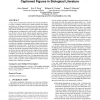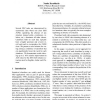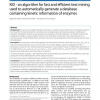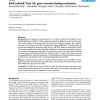47 search results - page 3 / 10 » Rutabaga by any other name: extracting biological names |
KDD
2009
ACM
14 years 6 months ago
2009
ACM
A major source of information (often the most crucial and informative part) in scholarly articles from scientific journals, proceedings and books are the figures that directly pro...
ACL
2006
13 years 6 months ago
2006
Several NLP tasks are characterized by asymmetric data where one class label NONE, signifying the absence of any structure (named entity, coreference, relation, etc.) dominates al...
BMCBI
2008
13 years 5 months ago
2008
Background: Although the UniProt KnowledgeBase is not a medical-oriented database, it contains information on more than 2,000 human proteins involved in pathologies. However, thes...
BMCBI
2010
13 years 5 months ago
2010
Background: The amount of available biological information is rapidly increasing and the focus of biological research has moved from single components to networks and even larger ...
BMCBI
2005
13 years 5 months ago
2005
Background: The biological research literature is a major repository of knowledge. As the amount of literature increases, it will get harder to find the information of interest on...




